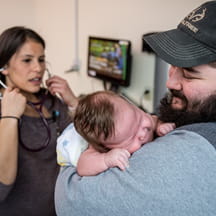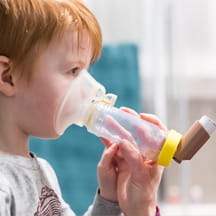Dr. Stefan Friedrichsdorf has yet to meet a kid who likes getting punctured with a needle. Yet needles — and the pain and anxiety that comes with them — are necessary for routine vaccinations, intravenous cannulations, and blood draws.
Clinicians and caregivers can eliminate or at least reduce the pain and anxiety associated with needles with proper planning, said Friedrichsdorf, the medical director of the Stad Center for Pediatric Pain, Palliative, and Integrative Medicine at UCSF Benioff Children’s Hospitals.
“If you ask every single child what they are most afraid of at the doctor, it’s the needle pain. It’s the number one problem of patients, yet most children’s hospitals only offer relief for some children, some of the time,” Friedrichsdorf said. “It is everyone’s problem — but nobody’s responsibility. It is high time for hospitals to allocate resources the address the number one concern of children.”
Effective pain control is important since anxiety about needles can follow children into adulthood. A study by the Centers for Disease Control and Prevention found 25% of adults are fearful of needles. The fear often stems from childhood experiences and causes adults to forego treatments, tests, or vaccination for themselves or their children, Friedrichsdorf said.
An evidence-based bundle
Pain and anxiety from needle procedures can be avoided or alleviated using an evidence-based bundle Friedrichsdorf implemented with his team as the new standard of care while working at Children’s Minnesota. The “Comfort Promise” treatment bundle has long been promoted by researchers, clinicians, and child life specialists and provides the modalities to every child — every time. Now the standard of care at Benioff Children’s Hospitals and dozens of children’s hospitals around the world, the Comfort Promise helps make injections and blood draws easier for patients of all ages.
The bundle includes four components.
- Topical anesthetics. Numb the skin with over-the-counter topical 4% lidocaine 30 minutes before the stick or EMLA-cream at least 60 minutes prior.
- Sucrose/breastfeeding. Give babies a drop of 24% sugar water or allow them to breastfeed two minutes before the needle to stop pain messages from reaching the brain.
- Comfort positioning. Do not restrain children and encourage comfort positioning, which can include skin-to-skin contact, swaddling, or sitting upright in a parent’s lap.
- Age-appropriate distractions. Provide distractions such as books, music, bubbles, toys, videos, or even rhythmic sounds.
Numb the skin
Topical anesthetics are safe and effective for term infants and older. “The numbing cream is vital,” Friedrichsdorf said. “It’s not vasoconstrictive. It does not make it more difficult to find a vein, and it does not impact the efficacy of vaccines.”
Sucrose or breastfeeding
Sugar water or breastmilk appears to release endorphins in the periaqueductal gray (PAG) area of the brain. This stimulates descending inhibiting pathways that prevent the brain from interpreting pain messages as threats.
Friedrichsdorf said a single drop of sugar water a couple of minutes before a needle stick significantly reduces pain among babies. That is important since critically ill infants in the neonatal intensive care unit (NICU) may experience more than 400 painful procedures during their stay. Without pain control, these patients are at increased risk of negative consequences like hypoxia, coagulopathy, respiratory incoordination, increased intracranial pressure, intraventricular hemorrhages, and reduced body and head circumference growth.
“Babies who are getting poked need more oxygen, so they have a higher risk of developing retinopathy of the eyes. They have a higher risk of getting brain bleeds. They have a higher risk of dying,” Friedrichsdorf said. “With numbing cream and sugar water, nearly all babies in the NICU sleep through a blood draw, which means they are happier and they're at decreased risk of any side effects. It also means nurses are free to focus on clinical care instead of calming crying babies.”
Age-appropriate distractions
Distractions run the gamut from swaying for an infant to virtual reality headsets for older kids. Friedrichsdorf said about 10% of kids chose to watch the injection or blood draw but most remain focused on the distraction tool.
Babies and toddlers often prefer spinning electrical light-up toys while preschoolers and elementary school-aged kids are drawn to apps like Tap 2 Distract. Bubbles work “magic” to engage young children, Friedrichsdorf said.
Comfort positioning
Friedrichsdorf said health care providers, himself included, have historically been trained to restrain the child and do the needle poke as quickly as possible to get it out of the way.
“Now we know this is a terrible mistake. This is absolutely, completely, utterly wrong, but that is how we were trained,” he said.
Children older than 6 months should be upright. Sitting close to a parent — often in a lap — helps. For babies, skin-to-skin contact with a parent can reduce procedural pain.
Change the conversation
Caregivers should also take steps to reframe the discussion about needle sticks with children, Friedrichsdorf said. Avoid negative words like “pain,” “hurt,” or “shot,” to make kids less afraid. Give children the ability to make decisions, when possible. Asking kids to select from a choice of distractions helps them feel more in control.
A cultural shift
Many caregivers view the pain associated with needles as a problem, but either don’t know the solution or are hesitant to change existing workflows. Hospitals that have implemented the Comfort Promise reported:
- Increased patient satisfaction.
- Increased pain control.
- Decreased waiting time.
- Decreased staff turnover.
Friedrichsdorf said any hospital may use the Comfort Promise bundle to make pain control a standard of care for all patients.
Ideally the effort would be led by an interdisciplinary team of doctors, nurses, child life specialists, quality improvement leaders, and lab personnel.
“Start by implementing the protocol for the most common painful procedure in your practice and then move to the second-most common,” Friedrichsdorf said. “You can go unit by unit to standardize this bundle and ensure it’s offered to every child, every time, everywhere in the hospital.”


